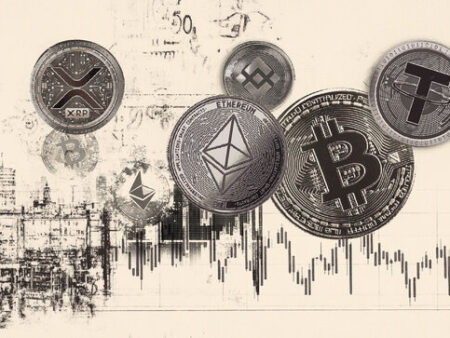XRP Poised for Breakout Amid Renewed Risk Appetite
Ripple’s XRP is showing signs of a potential short-term bullish trend, recovering from last week’s sell-off triggered by escalating geopolitical tensions in the Middle East following Israeli attacks on Iran. Currently, XRP is trading around $2.28, marking a 5% increase on Monday.
Other major cryptocurrencies, including Bitcoin and Ethereum, are also exhibiting bullish signals amid optimism surrounding a potential ceasefire between Israel and Iran.
XRP Gains Momentum as Risk Appetite Persists
Despite the volatility stemming from the tensions between Israel and Iran, interest in XRP is growing. Large-volume holders, possessing between 1 million and 10 million XRP, have continued to accumulate the cryptocurrency despite the macroeconomic and geopolitical uncertainties.
According to Santiment data, this group of investors now holds 9.9% of the total XRP supply, up from 9.5% on May 1st and 8.24% on January 1st.
This increased risk appetite among large holders is reflected in CoinShares’ weekly digital asset investment report, which highlights approximately $11.8 million in inflows into XRP-related financial products last week.
“Regional sentiment was positive, led by the U.S. ($1.9 billion), while altcoins such as XRP ($11.8 million) and Sui ($3.5 million) also saw renewed investor interest,” the CoinShares report states.
Meanwhile, the XRP futures open interest (OI) is holding steady at around $3.83 billion, suggesting consolidation within the micro-environment. While the OI has remained relatively stable, it has maintained a general downward trend from its recent peak of $5.52 billion in mid-May.
Open interest represents the number of futures and options contracts that have yet to be settled or closed. A stable OI suggests growing interest in XRP, with traders potentially betting on future price increases.
Technical Outlook: XRP on the Verge of a Breakout
XRP’s price is currently around $2.28, following the establishment of support at $2.09, bolstered by the 200-day exponential moving average (EMA).
Key indicators, including the Relative Strength Index (RSI) and the Moving Average Convergence Divergence (MACD), are providing bullish technical signals. The RSI’s return above the 50 midline indicates upward momentum, which is likely to keep XRP’s price stable in the coming sessions.
The MACD indicator is likely to validate a buy signal if the blue MACD line crosses above the red signal line. Traders may also monitor the indicator’s movement, with a recovery towards the midline alongside the expansion of green histogram bars potentially triggering a breakout from the descending channel.
A convergence of the 50-day EMA and the 100-day EMA at $2.25 serves as short-term support. Traders will be looking for a daily close above this level to confirm the strength of the bullish trend. Breaking above the descending channel resistance could further boost momentum as volume surges.
Key areas of interest in the future include $2.65, a seller congestion point 17% above the current level, and the $3.00 target, representing a 32% increase from the prevailing market value.
SEC vs. Ripple FAQs
- Is XRP a security?
It depends on the transaction, according to a court ruling issued on July 14:
- For institutional investors or over-the-counter (OTC) sales, XRP is a security.
- For retail investors who purchased the token through programmatic sales on exchanges, on-demand liquidity services, and other platforms, XRP is not a security.
- What is the SEC’s lawsuit against Ripple about?
The Securities and Exchange Commission (SEC) accused Ripple and its executives of raising over $1.3 billion through an unregistered asset offering of the XRP token.
While the judge ruled that programmatic sales are not considered securities, sales of XRP tokens to institutional investors are investment contracts. In the latter case, Ripple did violate U.S. securities law and will have to continue litigating for the approximately $729 million it received under written contracts.
- What are the implications of the ruling?
The ruling offers a partial victory for both Ripple and the SEC, depending on the perspective.
Ripple gains a significant victory because programmatic sales are not considered securities, which could bode well for the cryptocurrency sector in general, as most assets targeted by the SEC are managed by decentralized entities that sold their tokens primarily to retail investors through exchange platforms, experts say.
However, the ruling does not significantly help answer the key question of what makes a digital asset a security, so it is still unclear whether this lawsuit will set a precedent for other open cases affecting dozens of digital assets. Issues such as the appropriate degree of decentralization to avoid the “security” label or where to draw the line between institutional and programmatic sales are likely to persist.
- How does this affect the broader crypto industry?
The SEC has intensified its enforcement actions toward the blockchain and digital asset sector, filing charges against platforms such as Coinbase or Binance for allegedly violating U.S. securities law. The SEC claims that most crypto assets are securities and are therefore subject to strict regulation.
Although defendants may use parts of the Ripple ruling to their advantage, the SEC may also find reasons in it to maintain its current strategy of regulation through enforcement.
- What’s next in the Ripple case?
The court decision is a partial summary judgment. The ruling may be appealed once a final judgment is issued or if the judge allows it earlier. The case is in a pre-trial phase, in which both Ripple and the SEC still have the possibility of reaching an agreement.
Stay ahead of the curve in the fast-paced crypto world – explore the latest updates and trends at Cryptonewsfeeds.com.










